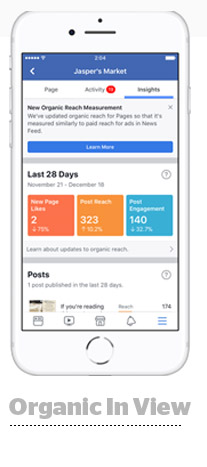
Publishers, prepare yourselves for another Facebook organic reach reality check.
Starting Monday, Facebook will finally begin measuring organic page reach the same way it measures paid ad reach: based on viewable impressions.
This is only a reporting change and unrelated to how organic distribution works on Facebook.
Facebook started alerting publishers in early February, but it’s been a long time coming. The change was first announced in November 2016 when Facebook told publishers the new measurement methodology would be implemented “in the coming months.”
Until now, Facebook had calculated organic page reach based on the number of times a post was delivered into someone’s news feed, even if the user never scrolled far enough to actually see the post.
On that score, it makes sense to change the definition of what counts toward reach to exclude posts that aren’t viewable.
Facebook has a liberal definition of viewability. An ad – and now an organic post – counts as an impression the moment at least one pixel appears on a user’s screen.
Nonetheless, Facebook warned publishers to expect a 20% decrease in the organic reach of their page posts when the new viewability methodology is put into place.
But even without the stricter definition of organic reach, unpaid distribution on Facebook is dead in the water.
In January, Facebook made a major change to its algorithm to prioritize content from friends and family in the news feed over content from businesses. Moving over to viewable reach for page posts will be more reflective of that reality and offer more consistent measurement reporting across paid and organic.
The message is clear, though: The news feed is pay-to-play for publishers and brands. And by aligning the reach measurement criterion for ads with organic pages, it will be even more obvious which provides better exposure on the platform.
Facebook will continue reporting organic reach using the old method for the next few months to give marketers who use that metric for their own reporting enough time to transition.
In addition to the shift to viewable organic reach, Facebook said Tuesday that it’s redesigning how page insights are displayed for mobile to better surface the most commonly used metrics, including info on likes, reach, engagement, recent post performance and demographic information on new followers.
This post was syndicated from Ad Exchanger.

More Stories
Retail Media Can Be Pricey. 4 Experts Break Down When It’s Worth the Cost
My Food Bag brings exclusive giveaways and fresh experiences to Auckland FC partnership
WBD Updates DEI Program to Only Say ‘Inclusion’ Amid Trump Crackdown